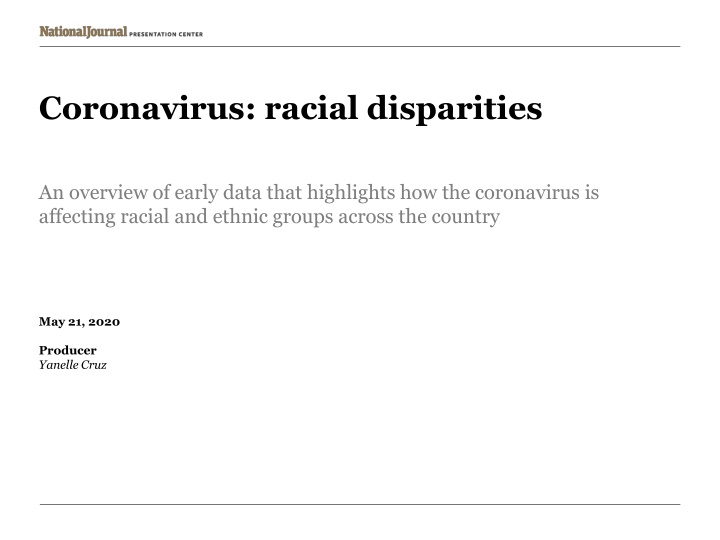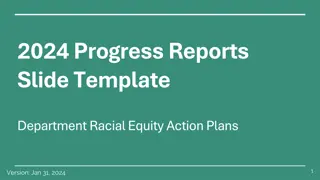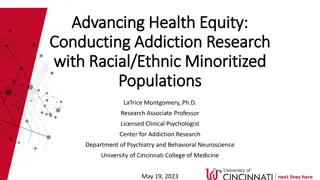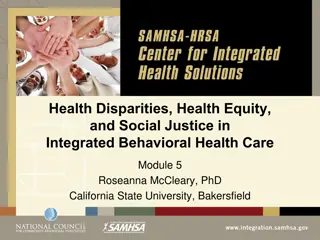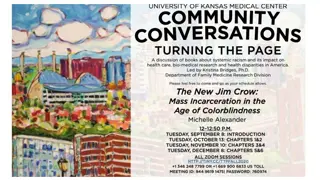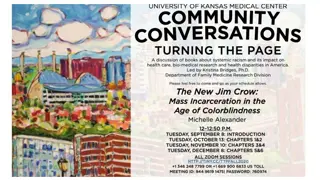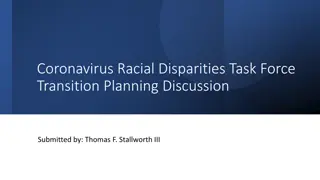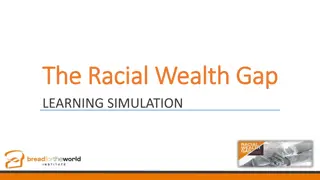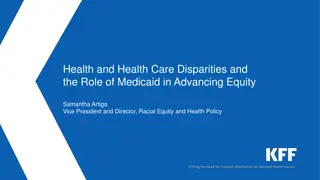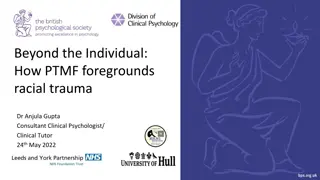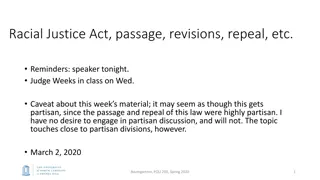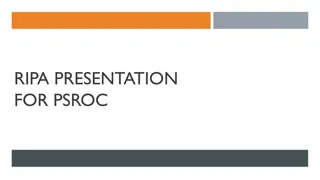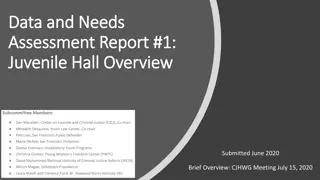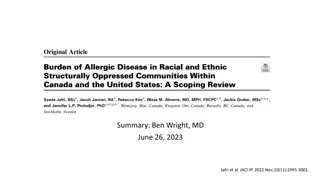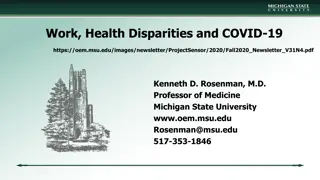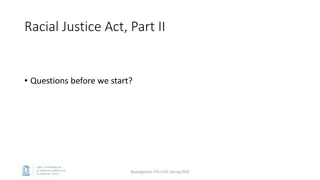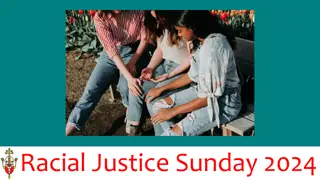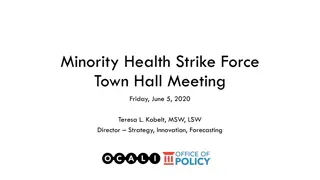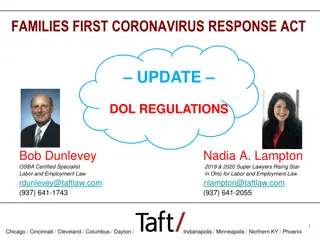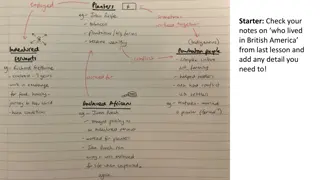Racial Disparities in Coronavirus Impact: Early Data Overview
Recent studies reveal alarming racial disparities in the impact of the coronavirus outbreak, with minority communities disproportionately affected across various states. African Americans and Hispanics are bearing a higher burden, facing increased mortality rates and expressing heightened concerns about personal health. Limited data underscore the urgent need for targeted interventions to address these disparities and protect vulnerable populations.
Download Presentation

Please find below an Image/Link to download the presentation.
The content on the website is provided AS IS for your information and personal use only. It may not be sold, licensed, or shared on other websites without obtaining consent from the author.If you encounter any issues during the download, it is possible that the publisher has removed the file from their server.
You are allowed to download the files provided on this website for personal or commercial use, subject to the condition that they are used lawfully. All files are the property of their respective owners.
The content on the website is provided AS IS for your information and personal use only. It may not be sold, licensed, or shared on other websites without obtaining consent from the author.
E N D
Presentation Transcript
Coronavirus: racial disparities An overview of early data that highlights how the coronavirus is affecting racial and ethnic groups across the country May 21, 2020 Producer Yanelle Cruz
Roadmap Impact on personal health Impact on personal finances
Despite limited data, recent studies show that racial minorities are being disproportionately affected by the coronavirus outbreak In early April, more than 70% of deaths in Louisiana were of African Americans victims, despite them being only 33%of the state s population. An analysis conducted by The Atlantic and the Antiracist Research and Policy Center found that as of April 12, 38% of the cases analyzed across 29 states lacked racial data. Therefore, despite statistics showing wide racial disparities there is still an incomplete picture of the coronavirus impact across racial groups. 63% of coronavirus cases with demographic data in Illinois were non-white individuals. Hispanics make up 17% of the state s population and African Americans make up 14%. Of the state s victims with racial data, 32.5% were African American. In Michigan, 41%of deaths were African American victims, despite them representing only 14%of the state s total population. In California, Latinos represent 53%of the state s positive coronavirus cases as of May 18, despite only representing 39%of the state s population. A CDC analysis of 1,500 hospitalizations in 14 states showed that African Americans made up a third of hospitalizations, despite representing only 18% of the population of the areas included in the analysis. As of early April, 34% of coronavirus deaths in New York City were Hispanic victims, despite them representing only 29%of the state s total population. 28% of deaths were African American victims, despite them representing only 22% of the state population. Sources: ABC News, The Atlantic, Indian Country Today, CNN, CNBC, New York Magazine. 3 Yanelle Cruz | Slide last updated on: May 20, 2020
In 40 states and DC, Black residents are more likely to die from coronavirus Coronavirus death rates per 100,000 people of each group DATA FROM 40 STATES AND THE DISTRICT OF COLUMBIA State spotlights: In Kansas, Black residents are 7 times more likely to die than White residents. In Missouri, Wisconsin and DC, Black residents are 6 times more likely to die. In Michigan, the death rate for Black residents is 5 times greater than for White residents. In Arkansas, Illinois, Louisiana, New York, Oregon and South Carolina, Black residents are 3 times more likely to die than Whites. 50.3 25.9 22.9 22.7 20.7 All deaths with known race Asian Black Latino White Sources: APM Research Lab. 4 Yanelle Cruz | Slide last updated on: May 20, 2020
Hispanic and Black adults express higher concern for their personal health Is the coronavirus outbreak a threat to your personal health? PEW SURVEY CONDUCTED MARCH 19-24, 2020 Major threat Minor threat Not a threat All adults 36% 52% 11% Black adults 49% 38% 12% Hispanic adults 48% 43% 8% White adults 30% 58% 12% How concerned are you that you may get the coronavirus and require hospitalization? PEW SURVEY CONDUCTED APRIL 7-12, 2020 Very concerned Somewhat concerned Not too concerned Not at all concerned All adults 24% 31% 32% 13% Black adults 31% 27% 22% 19% Hispanic adults 43% 27% 20% 9% White adults 18% 33% 37% 12% Sources: Pew Research Center. 5 Yanelle Cruz | Slide last updated on: May 20, 2020
Black Americans are being disproportionately affected by the coronavirus and dying at higher rates than any other race Racial health disparities to consider Numbers at a glance For every 100,000 Black Americans, 50 have died from coronavirus. Their mortality rate is more than double the rate for Asians, Latinos and Whites. Redlining and housing discrimination have forced many black adults into food deserts where healthy food options are limited or non-existent. A recent study conducted across 39 states and the District of Columbia found that collectively Blacks represented 12.9% of the population but 25.1% of deaths. Only 55.5% of black Americans had access to private health insurance in 2017, compared to 75.4% of white Americans. 43.9% relied on public health insurance and almost 10% lacked health insurance. Do you know someone who has been hospitalized or has died as a result of having COVID-19? PEW SURVEY CONDUCTED APRIL 7-12, 2020 54% of black Americans are employed in low wage jobs that often lack benefits. Many of these jobs have become essential during the pandemic which has increased the risk of exposure for all workers. 27% Implicit bias in healthcare has developed mistrust for black Americans because their health concerns are sometimes ignored or treated differently than other patients. The issue is more prevalent for black women due to the black maternal health crisis. 13% 13% White adults Black adults Hispanic adults Sources: Pew Research Center, CNBC, APM Research Labs. 6 Yanelle Cruz | Slide last updated on: May 21, 2020
Latinos are becoming the second most affected racial group in the country Racial health disparities to consider Numbers at a glance For every 100,000 Latinos, 23 have died from coronavirus. Their mortality rate is the second highest in the country alongside the Asian mortality rate. Many Latinos tend to live in multigenerational homes where social distancing and isolation are impossible. Many farmworkers live in barrack- style housing where they are unable to self-isolate if they are ill. A recent study conducted across 40 states and the District of Columbia found that collectively Latinos represented 18.5% of the population but 16.4% of deaths. Due to their inability to receive unemployment benefits, undocumented Latinos are pressured to continue working even when falling ill which contributes to the spread of the virus. State spotlight: Oregon 63% of Latino workers are employed in low wage jobs that often lack benefits. Many of these jobs have become essential during the pandemic and require face-to-face interaction which increases the risk of exposure for all workers. In Oregon, Latinos were found to be 20 times as likely as other screened patients to have the coronavirus. As a result, the state has expanded their testing criteria to prioritize Latinos and other minorities. The state welcomes around 160,000 Latino seasonal farmworkers during crop picking season. They work near each other and often live in crowded shared spaces, which could facilitate the spread of the virus. 17.8% of Latinos lacked health insurance in 2017,compared to 5.9% of white adults.Only 49% had access to private insurance and 38.2% had public health insurance. Sources: APM Research Lab, New York Times, CNBC, US Department of Health and Human Services. 7 Yanelle Cruz | Slide last updated on: May 21, 2020
The Navajo Nation has now reached the highest per-capita infection rate in the country Numbers at a glance As of April 12, almost one-third of positive cases in New Mexico were Native American individuals, despite them representing only about 11% of the population. The Navajo Nation spans parts of Arizona, New Mexico and Utah and reported a population of 173,667 on the 2010 census. As of May 18, Navajo Nation reported 4,071 positive cases and 142 deaths. The penetration rate of COVID-19 for the Navajo population is 2.3%, compared to 1.8% for New York state. Navajo Nation President Jonathan Nez stated that as of May 16, more than 23,000 members of Navajo Nation have been tested for the virus, accounting for about 11% of the total population. The fatality rate in Navajo Nation indicates that the region has suffered more fatalities than 13 other states. There are only five hospitals under the Navajo Area Indian Health Service. Due to the limited hospital infrastructure, Doctors Without Borders dispatched two teams to the region last month. Both teams are expected to remain in the region until June. The region has implemented a range of strict preventative measures, such as: Required face masks/coverings in public 57-hour lockdowns during the weekends Closure of the region s borders Essential workers must have documentation with company letterhead and contact information in order to be allowed to leave their home Only 30%of the region s population has access to running water which poses challenges to proper sanitation and handwashing. Additionally, the limited number of grocery stores in the region have increased risk of exposure for individuals shopping for essentials. Sources: The Hill, CNN, Forbes. 8 Yanelle Cruz | Slide last updated on: May 20, 2020
Roadmap Impact on personal health Impact on personal finances
Hispanic adults are the most impacted by job losses and pay cuts The coronavirus has hurt your personal finances ? PEW SURVEY CONDUCTED APRIL 7-12, 2020 More than most other people Less than most other people About the same as most other people Hispanic adults 12% 41% 47% Black adults 18% 33% 48% White adults 8% 59% 33% All adults 10% 52% 37% Because of the coronavirus outbreak, have you or anyone in your household ? PEW SURVEY CONDUCTED APRIL 7-12, 2020 Had to take a pay cut Been laid off or lost a job 51% 41% 34% 33% 32% 29% 28% 24% All adults White adults Black adults Hispanic adults Sources: Pew Research Center 10 Yanelle Cruz | Slide last updated on: May 20, 2020
Hispanic adults are struggling to pay their bills and many adults do not have emergency funds to cover expenses PEW SURVEY CONDUCTED APRIL 7-12, 2020 Cannot pay some of their bills Can pay all of their bills in full 51% 54% 53% 68% 70% 74% 75% 80% 48% 46% 44% 32% 28% 26% 24% 20% All adults White adults Black adults Hispanic adults All adults White adults Black adults Hispanic adults This month In a typical month Individuals who have emergency funds that would last at least three months, by race PEW SURVEY CONDUCTED APRIL 7-12, 2020 53% 47% 29% 27% All adults White adults Black adults Hispanic adults Sources: Pew Research Center 11 Yanelle Cruz | Slide last updated on: May 20, 2020
Childcare responsibilities have become more difficult for Black and Hispanic parents Adults with children under 12 who responded that handling childcare responsibilities during the outbreak has been PEW SURVEY CONDUCTED MARCH 19-24, 2020 Very/Somewhat difficult Very/Somewhat easy 71% 41%of lower income parents are very concerned about their children falling behind in school, compared to 21% of middle income parents and 17% of upper income parents. 65% 61% 60% 40% 38% 35% 38%of lower income parents said their children have received a lot of online instruction from their school, compared to 44% of middle income parents and 51% of upper income parents. 28% All adults White adults Black adults Hispanic adults Sources: Pew Research Center 12 Yanelle Cruz | Slide last updated on: April 20, 2020
School closures have become a challenge for lower income families due to lack of access to broadband To complete schoolwork at home, your child must ? PEW SURVEY CONDUCTED APRIL 7-12, 2020 All parents Upper income parents Middle income parents Lower income parents 43% 40% 36% 29% 24% 22% 21% 14% 13% 10% 6% 4% Use a cellphone Use public Wi-Fi due to lack of access at home Unable to complete their schoolwork due to lack of access Worries about being able to afford home broadband and smartphone bills PEW SURVEY CONDUCTED APRIL 7-12, 2020 All adults White adults Black adults Hispanic adults 56% 54% 39% 36% 30% 28% 22% 21% Broadband users worried about paying bills for broadband at home Smartphone users worried about paying their cellphone bill Sources: Pew Research Center 13 Yanelle Cruz | Slide last updated on: May 20, 2020
